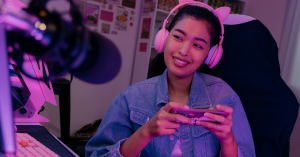Social media can be a powerful tool in your online gaming marketing strategy. It enables you to connect with your target audience, create brand awareness, and build lasting relationships. However, to create a winning social media marketing plan, you need to follow certain steps. In this blog, we will take you through seven steps that can help you create a strong and effective social media marketing plan that will help you achieve your goals. So buckle up, grab some snacks, and let’s dive right in!
Identifying the target audience
Identifying the target audience is crucial for social media marketing success in the video game industry. Understanding your game and its features is the first step towards identifying the appropriate social media platforms for promotion. For instance, if your game revolves around visual elements, platforms like Instagram and Pinterest might work better than LinkedIn.
Researching the target audience demographics and behaviors is equally important. It will help you tailor your content and messaging accordingly. For example, if your game is designed for older audiences, it makes sense to focus on platforms like Facebook rather than Snapchat.

By identifying your target audience, you can create a social media marketing plan that is more effective and efficient. With the right targeting, you can connect with gamers who are most likely to enjoy your game and become loyal brand advocates.
Choosing the Right Platforms for Your Game
Be where your audience is
One size doesn’t fit all in social media land, and the same goes for social media marketing for game developers. You can’t be everywhere, nor is it necessary, so how do you pick the right platforms for your game marketing? Consider the following aspects while choosing social media platforms: Understanding your audience: To make the most of social media platforms, it’s crucial to know your target audience inside-out.
Study their preferences, demographics, and their age group to figure out the social media platforms they frequently use. For instance, Facebook is a great platform to target the 40+ age group, while Instagram appeals to the 25-35 age group. Characteristics of various platforms: The way users interact with your content depends on the nature of the platform you use. For instance, Instagram and TikTok are primarily visual-centric platforms focusing on images and short-form video content, while Facebook gives you long-form text options.
Well, that’s some tradditional social media platforms, but how about platform that is dedicated to gamers only. We introduce to you Playee – an exclusive, diverse, and creative interaction platform. It’s where gamers like you can come together to share game reviews, find reload/download gates, and connect with fellow enthusiasts who share your passion
Read more about Playee and other Gamota’s project here: Playee & Gabros – The Ultimate Gaming Ecosystem
Leverage community group
Facebook and LinkedIn groups offer an opportunity to create a dedicated community around your game brand. LinkedIn is really popular B2B platform, a great place for game makers to demonstrate their products to potential game publishers
These groups offer flexibility to directly interact with your fans, build a sense of community, and gather feedback to make improvements. Ultimately, it’s not about being present everywhere but being there for your target audience, where they are most active. The trick is to zero in on those selective social media platforms where you can create engaging content and build a dedicated fan base. So do your research and make smart choices!
Creating a strong brand image
Consistency is key
Creating a strong brand image is crucial for any online game to stand out in the highly competitive gaming industry. The first step towards creating a strong brand image is developing a unique brand persona and brand voice that resonates with the target audience. Consistent messaging and design across all channels help reinforce the brand image.
Engaging visual content creation, including videos, images, and graphics, can attract and retain the audience’s attention, creating a lasting impression.
Incorporating user-generated content, such as fan art or gameplay videos, also helps in building a sense of community and promotes player engagement. Remember, a strong brand image is an ongoing process that requires consistent effort and a strong understanding of your audience’s wants and needs.
Content creation strategy
Keep your content plan organized
To create an effective strategy, start by creating a content calendar that outlines the type of content, posting frequency, and the channels to be used. When creating content, focus on balancing promotional and non-promotional posts to avoid overwhelming the audience.
Experiment with various content formats such as videos, images, and infographics to keep the audience engaged. It is also essential to engage the audience with contests and giveaways to keep them hooked.
Additionally, pay attention to the timing of the posts and focus on posting when the audience is likely to be active. By doing this, you increase the chances of your content getting noticed. Make sure to analyze the metrics regularly to identify the most effective content and strategies.
Use the data to make data-driven decisions and make adjustments to the marketing plan regularly. Creating an effective content strategy takes time, but by being consistent and willing to experiment, you will find what works best for your brand. So, keep creating and engaging with your target audience, and you will see results.
Think outside-of-the-box
To make an impact, you need to develop unique content ideas that will capture your audience’s attention. Remember, social media is a place for fun and entertainment, so let loose and get creative! While it may seem like a no-brainer, gameplay videos are still effective and popular.
As a game company, you want to show your audience what your game is all about. Gameplay videos offer a quick and easy-to-digest way of doing this. But don’t stop there. Almost any content idea will work on social media, however wacky. Don’t be afraid to push boundaries and show off your brand’s personality. Think outside the box and capitalize on trending topics.

For instance, when Kwalee celebrated April Fool’s Day, they announced that driving tests were being replaced by a mobile game, and that they developed tech which allows game devs to create games with just a single thought! This silly, yet creative post engaged their audience and generated excitement around the brand.
Or Fornite for example, this game has used social media to promote its various in-game events and collaborations. For example, they partnered with Houseparty to create a Fortnite Trivia Challenge, where players could win an exclusive in-game skin. The initial teaser tweet from Fortnite had more than 21,000 likes
Engaging with the audience
Be authentic with the player
As a gaming company or a game maker, you will frequently face gamers either complaining about bugs or asking for changes. When gamers reach out to you with questions, comments, or feedback, take the time to respond to them. It shows them that you genuinely care about their gaming experience by addressing their concerns and offering solutions.
Always be present on social media to communicate with your audience. If you stay accessible and responsive, it builds a sense of trust and fosters a positive relationship with your community.
How about trolls’ comments that are intentionally trying to screw you up? Well, we advise you to answer properly to those comments with clear evidence. Silence can make the community question your commitment.
If the situation continues, post a Disclaimer or a Correction post dedicated to handling those trolls. People need to know and hear those words from the own creators, not some unconstructive feedback from naysayers
User-generated content and influencer collaboration
Utilizing user-generated content is key. Think about it: do your players enjoy your game? Then they’ll love any chance to be featured on your social media pages. Sharing fan art, memes, and other community-generated content will not only make your followers feel appreciated but also operate as easy-to-digest content (meaning that it’s straightforward and comprehensive).

Collaborating with influencers in the gaming community is another effective way to engage the audience, increase reach, and drive conversions. Online discussions offer a platform to initiate conversations, encourage feedback, and receive insights into the players’ preferences and pain points.
Taking part in discussions not only build engagement levels but can also give a competitive edge. So, take an active step to engage with your audience and reap the benefits of increased loyalty and trust.
Don’t underestimate paid ads
Paid advertising involves bidding in real-time auctions to display ads on specific platforms or networks. Some common forms include paid search, social media advertising, banner ads, and native ads. But, is it worth it? Well, using paid ads is like you pay for the platform providers like Facebook or TikTok a fee for their services, which means you will have more authority and power than using organic methods

Moreover, organic methods lack immediate impact, making paid campaigns essential for instant results. So, you should consider paid advertising a fundamental element of your sales and marketing strategy. But remember, choosing the right platform and allocating the advertising budget wisely is crucial. Don’t use fake ads (ads that overexaggerate the gameplay aspects) either or you want your game’s reutation to be ruined in just a day
Measuring and analyzing social media performance
Measuring and analyzing social media performance requires tracking important engagement and reaching metrics to understand what content is resonating with your audience. By analyzing these metrics, you can identify the most effective content and strategies that lead to conversions.
Making data-driven decisions based on this information allows you to adjust your marketing plan regularly and stay on top of changes in your audience’s behavior and preferences.
Remember to look at qualitative data such as in-depth interview transcripts, answers to open-ended survey questions, audio-visual recordings and images as well, not just the numbers if you want to gain a deeper understanding of how your audience is responding to your content. Use these insights to execute your social media marketing strategy with even greater precision and effectiveness.
Tools for a Successful Social Media Marketing Campaign
Social media management tools
Social media management tools are essential for game marketers looking to manage multiple social media accounts without feeling overwhelmed. These tools not only help simplify the management process but also help with content planning, scheduling, and analytics. Some of the popular social media management tools used by game developers include Hootsuite, Sprout Social, SocialPilot or Buffer
Design tools
Canva, Adobe XD or Figma are the best tools for creating high-quality visuals, graphics, and videos for social media. Its user-friendly interface and extensive library of templates make it easy to create professional-looking graphics, even if you don’t have design skills.
Outsource tools
Additionally, Fiverr, Upwork are great places to find freelancers who can help with tasks such as creating videos or voice overs that you don’t have the in-house capabilities for. You can hire freelancers with top-notch quality with a decent price point

Written Content creation tools
One essential tool for any social media manager is Grammarly, which ensures that you don’t make grammatical mistakes in your content. It’s a must-have tool for any social media manager who juggles multiple things at once.
Generative AI tools like ChatGPT, Cohesive or ContentShake by SemRush are also recommended for idea generation. But remember to not to reup the whole content written by them as the models can make up the whole things, without any evidence or cited source. You always have to proofread and customize the content after you publish it.
Analytics tools
analytics tools like Google Analytics, Facebook Insights, SemRush allow you to track the performance of your social media posts and campaigns. With this data, you can identify what resonates best with your audience, adjust your strategy accordingly, and track your progress over time.
Win Big on Social Media Channels with Gamota
In conclusion, winning at social media marketing for online games requires a thorough understanding of your target audience, creating a strong brand image, implementing an effective content creation strategy, engaging with the audience, and analyzing social media performance regularly. Consistency is key to success, and it’s essential to monitor and respond to comments and mentions and collaborate with influencers and gaming communities.
Well, we know that some just want to focus on developing your game, that’s totally fine. Then, just leave all the work to us, your trustful game publisher. With our comprehensive publishing service, your game can scale up to the next level in the Vietnam game industry in no time

